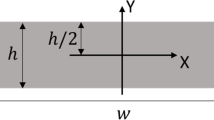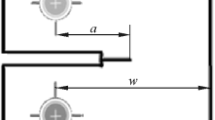Abstract
We present an approximate approach to assessment of the effect of the strain rate (γ) on the size (rp) and shape of the plastic zone near a transverse shear crack tip. The analysis is based on including the parameters of the stress—strain diagram for the material as functions of\(\dot \gamma \) in the quasistatic solution for rp. We propose a two-parameter model for taking into account the effect of the magnitude of the applied shear stresses on the geometry of the plastic zone. For a crack in mild steel, we obtain estimates of the evolution of the plastic zone as the strain rate varies within the range 10−4−103 sec−1.
Similar content being viewed by others
References
J. R. Klepaczko, “Dynamic crack initiation, some experimental methods and modelling,” in: Crack Dynamics in Metallic Materials, Springer-Verlag (1990), pp. 255–453.
J. R. Klepaczko, “A practical stress—strain rate—temperature constitutive relation of power form,” J. Mech. Working Technol.,15, No. 2, 143–165 (1987).
G. R. Irwin, “Plastic zone near a crack and fracture toughness,” Proceedings, Seventh Sagamore Conference (1960), pp. IV54-63.
D. Broek, Elementary Engineering Fracture Mechanics, 4th rev. ed., Martinus Nijhoff Publ. (1987).
L. Banks-Sills and D. Sherman, “Elasto-plastic analysis of a mode II fracture specimen,” Int. J. Fract.,46, No. 2, 105–122 (1990).
C. F. Shih, “Small scale yielding analysis of mixed mode plane-strain crack problems,” Fract. Analysis: ASTM Spec. Techn. Publ., No. 560 (1974), pp. 187–210.
J. Pan and C. F. Shih, “Elastic—plastic analysis of combined mode II and III crack-tip fields under small-scale yielding conditions,” J. Appl. Mech.,57, No. 2, 259–267 (1990).
N. Aravas and S. M. Sharma, “An elastoplastic analysis of the interface crack with contact zones,” J. Mech. Phys. Solids,39, No. 3, 311–344 (1991).
S. G. Larsson and A. J. Carllsson, “Influence of non-singular stress terms and specimen geometry on small-scale yielding at crack tips in elastic-plastic materials,” J. Mech. Phys. Solids,21, No. 3, 263–277 (1973).
J. R. Rice, “Limitations to the small scale yielding approximation for crack tip plasticity,” J. Mech. Phys. Solids,22, No. 1, 17–26 (1974).
M. F. Kanninen and C. H. Popelar, Advanced Fracture Mechanics, Oxford Univ. Press, Oxford, UK (1985).
H. Tada, P. Paris, and G. R. Irwin, The Stress Analysis of Cracks: Handbook, Del Research Corp., Hellertown (1973).
M. P. Savruk, Stress Intensity Factors in Cracked Solids: Handbook [in Russian], Nauk. Dumka, Kiev (1988).
J. R. Rice and G. F. Rosengren, “Plane strain deformation near a crack tip in a power-law hardening material,” J. Mech. Phys. Solids,16, No. 1, 1–12 (1968).
J. W. Hutchinson, “Singular behaviour at the end of a tensile crack in a hardening material,” J. Mech. Phys. Solids,16, No. 1, 13–31 (1968).
J. W. Hutchinson, “Plastic stress and strain fields at a crack tip,” J. Mech. Phys. Solids,16, No. 4, 337–347 (1968).
Z. Z. Du, C. Betegon, and J. W. Hancock, “J dominance in mixed mode loading, “Int. J. Fract.,52, No. 3, 191–206 (1991).
J. D. Campbell and W. G. Ferguson, “The temperature and strain-rate dependence of the shear strength of mild steel,” Phil. Mag.,21, No. 1, 63–82 (1970).
K. Tanaka and M. Kinoshita, “Compressive strength of mild steel at high strain rates at high temperature,” Bull. JSME,10, 429–440 (1967).
J. R. Klepaczko, “The strain rate behavior of iron in pure shear,” Int. J. Solids Struct.,5, No. 6, 533–548 (1969).
J. F. Kalthoff and S. Winkler, “Failure mode transition at high rates of shear loading,” in: Impact 87: International Conference on Impact Loading and Dynamic Behaviour of Materials, DGM Informationsgesellschaft Verlag, Oberursel (1987), Vol. 1, pp. 185–195.
Author information
Authors and Affiliations
Additional information
Translated from Problemy Prochnosti, No. 3, pp. 46–55, March, 1995.
Rights and permissions
About this article
Cite this article
Varfolomeev, I.V., Klepaczko, J.R. Effect of strain rate on the geometry of the plastic zone near a Mode II crack tip. Parametric analysis. Strength Mater 27, 138–145 (1995). https://doi.org/10.1007/BF02209479
Received:
Issue Date:
DOI: https://doi.org/10.1007/BF02209479




